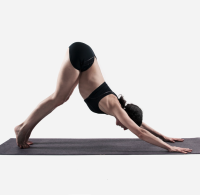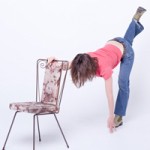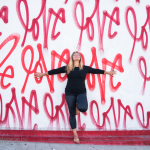by Melissa Billington, Ear2Earth
Yoga is a self-regulating practice.
It’s a yoke, a disciplined and regular practice that harnesses our innate animal power/prowess and enables us to see our own self-sabotaging habits and tendencies.
And, armed with that awareness and new tools for transformation, we are empowered to change those tendencies and habits of self-sabotage into tendencies and habits of transmutation and transformation.
We can become the opposite of our deepest darkest fear, by taking its power, its energy, and flipping it on its head.
No one else is in there but You and half the time even you’ve wandered off.
So how can you expect someone else to “fix” you or cure you?
Patient, heal thyself.
That’s why I call the yoga I offer, MYOGA. MYOGA is a fusion.
It contains within it multitudes: Kundalini, Kripalu, Anusara, Jivamukti, Iyengar, Bikram, Svaroopa, Scaravelli, Angela Farmer, Ana Forrest, First Nation paradigm, Zen meditation, mudras, Nada yoga, my mother, my father, the students who’ve studied with me, my own explorations, poetry, philosophy, experimentation…
I found any class or teacher or style I went to taught me something, even if it was a clear message as to what I wouldn’t do once I started teaching. I realized that was just as vital to recognize as what I would do, so I made notes.
And I also realized that we all assume too much, of ourselves and of others.
If we’re honest, we need to simplify, to pull it back to the bare Basics.
Initially, training at Kripalu, I found the amount of time we spent warming into fuller postures annoying. Why couldn’t we just get to the main thrust of it all — the asanas, and the fancy ones, at that?
Why not? Because most of us are not, honestly, fit to go that far, that fast.
What I then discovered in teaching is that if I listened closely to the dialogue that I consider teaching yoga to be, that many people needed to take it even a further step back. So the Basics of MYOGA was born.
If most of us are lying or sitting for most of our life hours — in bed, on toilet, in a car, at a desk, at the eating table, back to bed — then how are we going to have the open joints that the squatting Indian culture has?
We have to start with simple things and perfect those — squatting, opening toes, fingers, ankles, wrists, gaining spinal flexibility and core strength to support the spine, greater awareness and freedom in the hip and shoulder mantles.
We start with the bridge between mind and body — the breath.
Where is it in the body? How expansively can you inhale without strain? How completely can you exhale, again without force? Are your breathing muscles bound and need to be opened, stretched and strengthened?
Then fingers, wrists ankles and toes. If these are not open, how can you expect to put any weight on them without compressing those joints and all the ones above them in a posture like Down Dog?
As below, so above. In Downward Dog, if the hands are not open and aligned, neither will the shoulders or spine be. If the feet are not aligned, neither will the knees or hips be.
So we learn how to align and begin to notice our habitual patterns of alignment that oftentimes feel aligned, but when we actually look, are not. This seems so obvious, but is it? Have you really looked?
When we don’t recognize where we actually are right now, and work honestly from that place, then we simply perpetuate misalignments and deepen patterns that keep us stuck.
In order to unstick ourselves we need to slow down, open our eyes, breathe more consciously and drop some of the ego vanity that is avoiding the truth.
Take Down Dog (Adho Mukha Svanasana) as an example.
This is such an assumed posture in most yoga practices that it’s nearly ubiquitous. Yet most people end up deepening their already-existing strain on the low back and the tension in the shoulders by not breaking it down into parts, addressing those developmental areas and then putting it all together consciously.
In the MYOGA Basics Series we don’t get into Down Dog until week 6.
We touch on it briefly in week 5, but essentially we’re building all 6 weeks towards that one “tricky” pose. For most practitioners, the ego aims to drive the heels to the ground, rounds the low back towards the sky, taking it out of its lordosis, its natural inner curve.
When we develop core strength to stabilize the low back and to lift the pelvis and then only take the heels down (unbend the knees) as far as the low back integrity isn’t disturbed, we’re not likely to go as far as fast, but we do it with integrity, as a unified being.
This is no small thing. This is every thing. When we sacrifice the rest of the body for one aim, we suffer.
We cut ourselves off from our own integrity. Granted, most of us live in a paradigm where this is normal, even lauded and rewarded. So it’s no mean feat to humble ourselves to the wholeness of ourselves and take the longer journey.
If we fear not keeping up, or not doing as well as the next person, then in this seemingly backwards approach, instead of trying to keep up, we’re purposefully slow down. Break-it-down!
Establish an honest foundation by bravely working from where and how you are right now. Get pedantic and particular and patient. Then as you build your long lines of integrity and inhabit yourself with your breath – your consciousness -stuck places slowly but steadily begin to open.
In my experience, if you can do these practices slowly, with precision and awareness, then and only then can you pick up the pace and do so without losing your centredness and integrity.
At whatever pace, you come home to yourSelf. That’s what the MYOGA Basics Series is all about – it’s something to guide you home to yourself. Six hours of audio, plus a photobook with each practice (six classes of an hour long each.)



Leave a Reply